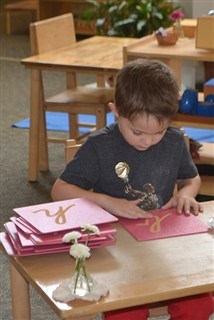News
News
Ask a Division Head: How Does Springmont Prepare Students to Read?

Springmont students begin to develop reading readiness skills as very young Primary students. In the Practical Life area, children learn to complete tasks from beginning to end and to coordinate eye movements by moving left to right. Sensorial materials provide opportunities to observe subtle similarities and differences leading to the skills needed to identify letters and to notice word patterns. Primary children are given more and more complex tasks, allowing them to extend their ability to concentrate for longer and longer periods of time.
Simultaneously, children are exposed to the richness of the English language through songs, poems, books and storytelling as well as the numerous conversations and daily social interactions between the children and teachers. For example, a teacher may guide a young student who is sharing a story about his trip to the beach to include as many details as possible using as much descriptive vocabulary as he is able.
Our multi-aged classrooms expose students to children in various stages of reading which aides in building the confident “I can do it” attitude vital to reading readiness. Teachers guide students to discover their reading skills as they play learning games like “I spy with my little eye…something that begins with the sound 'b'”, a fun exercise in which the student is exposed to word sounds well before being given a lesson with the Sandpaper Letters. Often students are capable of “writing” down their thoughts using the Moveable Alphabet before they are ready to decode and before their fine motor skills are ready to write using pencil and paper. “Writing” or taking words apart through encoding allows children to discover that reading is simply the reverse, putting sounds together to form words via decoding.
You can help your child at home by playing rhyming games - “I’m thinking of something on the table that rhymes with moon.” (spoon) – or by playing “I Spy” - “I spy with my little eye something that start with the sound ‘t’.” (tree). As your child becomes proficient with initial sounds, you can play “I Spy” with ending or middle sounds. Your child will eventually be ready for complex challenges such as “I’m thinking of something that has these three sounds ‘cuh’, ‘aaa’, ‘tuh’.” (cat). Clapping out syllables (banana = 3 claps, pumpernickel = 4 claps) is a fun way to build your child’s awareness of syllables. And most importantly, read to your child each day, before, during and even after they become independent readers.


2 days ago
3 days ago